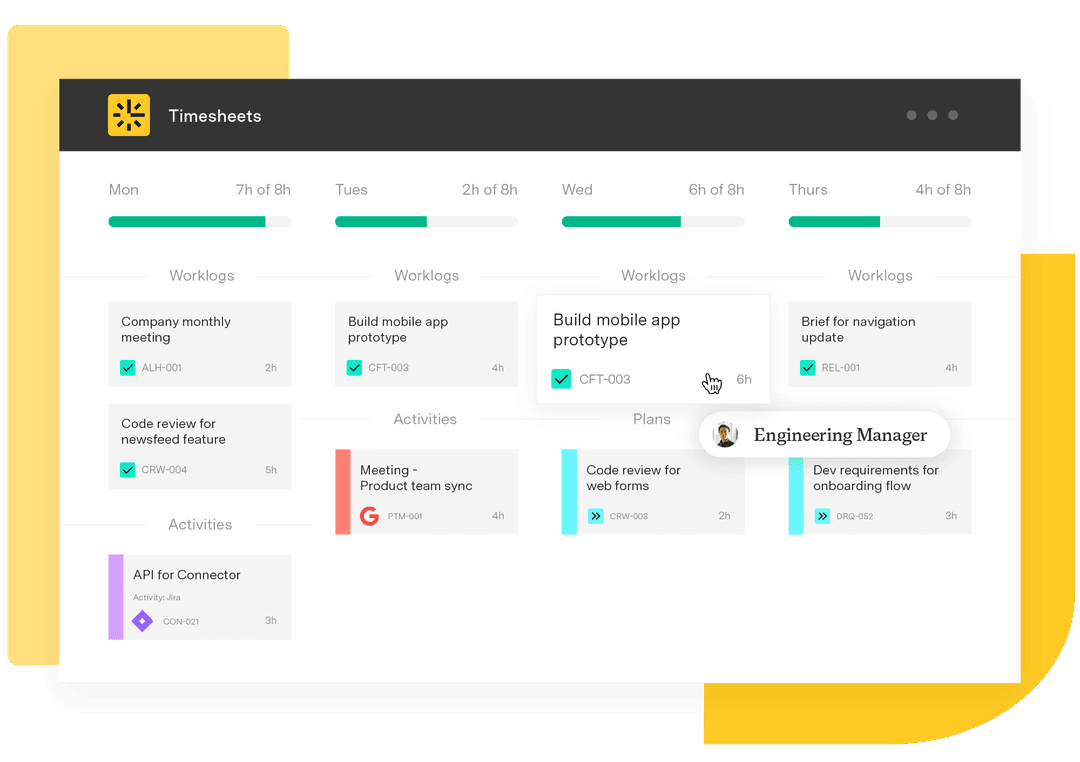Transactional leadership: A guide to structure and goals
Tempo Team
If you’re a project manager, chances are you’ve handled your fair share of high-stakes launches and tight turnarounds – situations with no room for guesswork. Each task needs a clear finish line, and every milestone has a measurable outcome. To motivate employees, wins earn rewards, while shortfalls carry consequences.
That’s transactional leadership in action, one of several well-established leadership theories that managers use to direct their teams.
In this guide, we’ll explain what transactional leadership is, when it works best, and its key advantages and limitations. We’ll also highlight Tempo’s tools that help transactional leaders track progress and maintain accountability across projects.
What’s transactional leadership?
Transactional leadership is a management approach built on a simple exchange: Meet expectations and earn rewards, but fall short and face corrective action. The “transaction” is transparent from the start, and performance standards are tied directly to recognition, incentives, or penalties.
Transactional leaders emphasize order, structure, and adherence to established processes. The goal is stability and consistent outcomes, making this style of leadership effective in fields where precision is key, such as manufacturing, finance, and compliance-driven industries.
Two elements define the transactional leadership style. Contingent rewards link incentives directly to performance goals, while management by exception means leaders step in only when results slip below the agreed standard. This cause-and-effect system keeps employees focused and productive.
Transactional leadership examples
Real-world transactional leadership examples often appear in settings where structure and measurable results define how teams do their work. It could be an emergency response team coordinating evacuations, a sales manager pushing quotas with commission, or a military unit following orders through a strict chain of command. In each case, this transactional leadership style uses rules and targets to achieve organizational results.
Transactional vs. transformational leadership
Unlike transformational leadership, which works to inspire through vision, personal growth, and innovation, the transactional approach centers on structure, short-term goals, and measurable results. Understanding the difference between transactional leaders and transformational leaders helps managers choose the leadership model that’s most effective for their organization.
Advantages of transactional leadership
The transactional leadership style isn’t right for every organization, but in the right setting its structured, goal-focused approach offers several benefits.
Provides clear structure and expectations
Leaders set specific roles, timelines, and deliverables. Team members know exactly what’s expected and how their performance will be measured, reducing misunderstandings and keeping projects on track. This clarity is especially valuable for new managers stepping into their first leadership role.
Effective for achieving short-term goals
Because expectations are explicit and progress is closely monitored, this style of leadership works well for projects with firm deadlines and measurable outcomes. The priority is meeting short-term goals and maintaining consistency, rather than overhauling the entire organization.
Reduces ambiguity and confusion
The direct link between set goals, monitored results, and defined consequences leaves little room for uncertainty. Employees understand the standards they must meet and the penalties for falling short.
Supports accountability
Transactional leadership creates transparency that supports accountability at both team and individual levels, making underperformance easier to spot and address quickly. Documented goals tied to measurable results are key to tracking performance and correcting issues promptly – a core skill in being a great leader in any organizational culture.
What are the characteristics of transactional leaders?
Certain traits define a transactional leader and shape how they communicate, set expectations, and measure success. Understanding these leadership qualities helps an organization decide when the transactional style will be most effective and how it influences team performance.
Focus on contingent rewards
In transactional leadership, performance incentives are central. Transactional leaders use bonuses, recognition, and other rewards to encourage employees to meet specific goals. This results-driven approach leaves little room for ambiguity.
Manage by exception
Rather than overseeing every detail, transactional leaders practice management by exception. Active management addresses potential issues early, while passive management only takes action after problems arise. In either case, leaders let processes run as long as they remain on track, stepping in only when results slip.
Emphasize short-term goals
Transactional leaders often prioritize short-term goals over distant objectives. Larger goals are broken into smaller, measurable tasks that can be tracked and completed efficiently.
Adopt a practical and pragmatic approach
Known for efficiency and consistency, transactional leaders focus on proven solutions that work within existing systems. This is especially valuable in industries like finance, manufacturing, and logistics, where reliability is critical.
Motivate through self-interest
In transactional leadership, both leaders and employees benefit from meeting quotas or achieving personal objectives because it creates a shared self-interest in results. Collaboration happens when it supports these goals, but the emphasis often stays on recognizing high performers who consistently meet targets and show potential for advancement into leadership roles.
Disadvantages of transactional leadership
Transactional leadership can contribute to a sense of order and predictability, but it also comes with drawbacks. Many are common leadership challenges that managers across industries face, but they’re still important for organizations to consider when deciding if the transactional leadership style is the right fit for an organization.
Stifle creativity and innovation
Because it focuses on adherence to established processes, transactional leadership can discourage experimentation or creative problem-solving. Teams may become accustomed to routine and, over time, stop proposing new ideas.
Lower employee engagement
When the focus is only on meeting targets and following rules, employees can feel less invested in their work. Without opportunities for growth or innovation, they may lose motivation and their sense of personal connection to their role.
Limit focus on long-term development
Transactional leadership often prioritizes immediate results over future potential. Leaders may miss opportunities to build skills, develop leadership in others, or make changes that help the team succeed in the long run.
Encourage over-reliance on the leader
Because decision-making is centralized, teams can become too reliant on the leader’s direction. While the leader’s expertise may keep KPIs on track, this dependence can limit independent thinking and problem-solving. Over time, some leaders may stop seeking input from their teams, which often leads to disengagement, lower morale, and a top-down dynamic that hinders collaboration.
Providing clarity and structure with Tempo
Transactional leadership works best when responsibilities, performance metrics, and goals live in the same tools your team already uses. Tempo’s suite of Jira-native solutions makes that possible.
With Timesheets, you see exactly how every hour is spent across projects. Compare actual time to estimates and catch workload imbalances before they cause bottlenecks. Financial Manager connects budgets to real-time project data, so you can monitor spending, forecast costs, and make adjustments before you overspend. By linking performance to financials, every initiative progresses in sync with your goals and resources.
Stay on top of the work, shift gears when you need to, and finish what you start on time, every time – with Tempo.












































